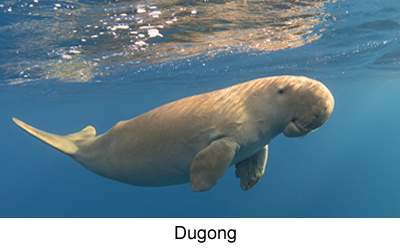 |
|
Name:
Dugong Classification:
Class: Mammalia
Order: Sirenia
Family: Dugongidae
Genus: Dugong
Species: D.
dugon
Size: 8-10ft long. Characteristics:
Long, pudgy body covered in skin, roundish head with two small eyes,
large nose and thick lips, two flipper-like "feet", long tail
with whale-like fluke. Adult males have tusks.. Status:Vulnerable.
Sometimes members of the same family can look very different even though they're related. This is the case with elephants, which have cousins that live in the ocean! Dugongs, which are closely related to manatees, live in the warm coastal waters of east Africa, India, the Red Sea, Australia and the Coral Triangle. Dugongs, like manatees, are completely aquatic mammals. Unlike manatees, they exclusively live in marine waters, though sometimes they will venture into brackish water. Dugongs and their manatee relatives are often called "sea cows". They spend most of their time grazing on seagrass fields. Dugongs are notoriously shy, which makes studying them difficult. There is still a lot we don't know about dugongs. What we do know is that they can grow as big as ten feet long and weigh as much as 1,100 pounds! Dugongs usually swim alone or in pairs, though occasionally they gather in groups of a hundred. Dugongs, along with manatees, are the only living herbivorous marine mammals in the world. It's known that dugongs become old enough to breed between eight and eighteen years old. There is a debate as to when females start to reproduce; perhaps between ten and seventeen years old. After 13-15 months, a female will give birth to a calf. A typical dugong calf is four feet long and weighs 66 pounds! A calf is capable of eating seagrass as soon as it's born, but it will nurse for 14-18 months. A dugong can live as long as 70 years. Does the tail of a dugong look familiar? Some people think that dugongs were the inspiration for the mythical mermaids! Sailors in ancient times may have seen dugongs and mistaken their vaguely human shape and whale-like tail for a half-man-half-fish. Who knew Ariel was a vegetarian?! Dugongs are currently classed as vulnerable by the IUCN. Historically dugongs have been hunted for their meat as well as their oil, hides and for traditional medicines. In recent times it has become illegal to hunt dugongs, however they are still poached. Other major threats include bycatch, destructive fishing practices, boat strikes, and excessive tourism. Habitat destruction is also a concern, as sea grasses meadows are increasingly threatened means a less food for dugongs. Many countries have enacted laws to protect dugongs. The United Arab Emirates, Japan, Kenya, Australia, Palau, Tuvalu, India, Sri Lanka, China, Bahrain and the Philippines have all outlawed the intentional killing or harassment of dugongs. Papua New Guinea has outlawed hunting except for traditional practices. An illegal dugong-hunting ring was also exposed and shut down in Vietnam in 2012. Organizations like the Dugong and Seagrass Conservation Project are fighting to preserve these marvelous creatures and the underwater meadows they call home. With international cooperation, research, and hard work, the dugongs can be put on a path to recovery. To learn more about these "sea cows" and how to help them, check out the links below! Dugong and Seagrass Conservation Project-Dedicated to preserving the du-gong and seagrass habitat! https://www.dugongconservation.org Great Barrier Reef Marine Park Authority, Dugong Page-Check out what the Australian government has done for dugongs! http://www.gbrmpa.gov.au/the-reef/animals/dugong And a reminder: there is ZERO scientific evidence for animal parts being an effective medicine for any medical condition! You can help dugongs and many other animals by NEVER supporting the medical animal trade and demanding action on banning this practice! |
|
|
|
|
||
|
Contact
Us
|
||||
|
Taproot
Guru © ALL RIGHTS RESERVED
|
||||